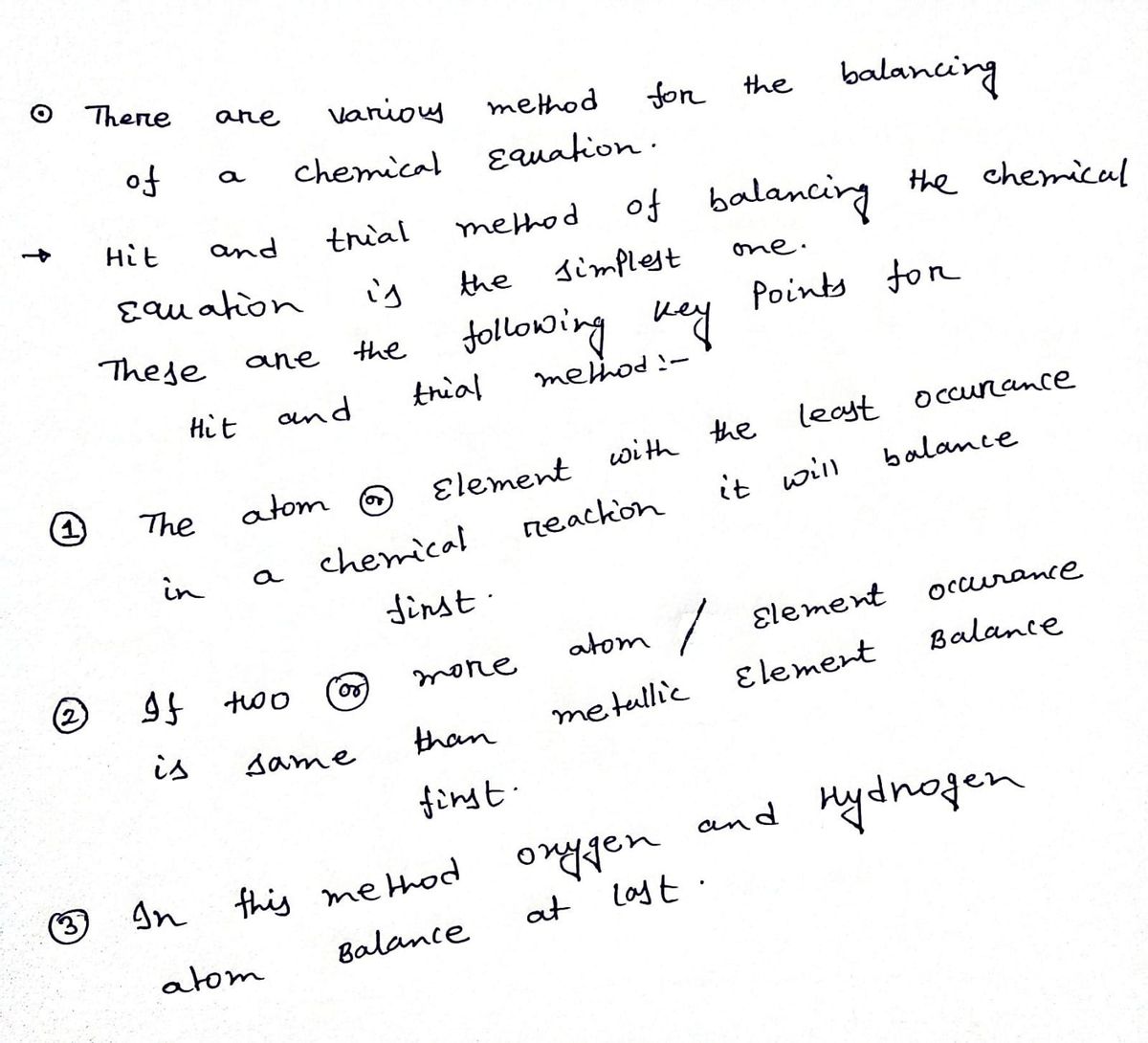Chemistry
10th Edition
ISBN:9781305957404
Author:Steven S. Zumdahl, Susan A. Zumdahl, Donald J. DeCoste
Publisher:Steven S. Zumdahl, Susan A. Zumdahl, Donald J. DeCoste
Chapter1: Chemical Foundations
Section: Chapter Questions
Problem 1RQ: Define and explain the differences between the following terms. a. law and theory b. theory and...
Related questions
Question
100%
balance the following chemical equation (if necessary)
![**Balancing Chemical Reactions: Interactive Activity**
On this page, you'll find an interactive tool designed to help students learn how to balance chemical equations. Below is a sample equation ready for balancing:
**Equation to Balance:**
\[ \text{C}_3\text{H}_6\text{O}_2(g) + \text{O}_2(g) \rightarrow \text{H}_2\text{O}(g) + \text{CO}_2(g) \]
**Instructions:**
1. **Interactive Interface:**
- Use the numeric keypad to input coefficients that will balance the equation.
- The equation has spaces to input numbers before each molecule's formula (e.g., before \(\text{C}_3\text{H}_6\text{O}_2\), \(\text{O}_2\), \(\text{H}_2\text{O}\), and \(\text{CO}_2\)).
2. **Control Buttons:**
- **Reset Button:** Clear any inputs and start over.
- **Navigation Arrows:** Use to move between spaces for coefficients.
- **Delete Button:** Remove any erroneous entries.
3. **Symbols and States:**
- **(g):** Indicates gas phase.
- **Plus and Arrow:** Use these for constructing equations.
- **Additional Elements:** Include options to input other familiar chemical formulas and states such as (s) for solid, (l) for liquid, and (aq) for aqueous solutions.
Explore the properties and reactions of molecules by achieving a balanced equation. Balancing equations is a fundamental skill necessary for understanding chemical reactions and stoichiometry. Happy balancing!](/v2/_next/image?url=https%3A%2F%2Fcontent.bartleby.com%2Fqna-images%2Fquestion%2Fe60afec2-8270-463c-8466-04e9f64c353b%2Fa622054b-e20f-439c-a3f4-6a5040675d11%2Fdp340lh_processed.jpeg&w=3840&q=75)
Transcribed Image Text:**Balancing Chemical Reactions: Interactive Activity**
On this page, you'll find an interactive tool designed to help students learn how to balance chemical equations. Below is a sample equation ready for balancing:
**Equation to Balance:**
\[ \text{C}_3\text{H}_6\text{O}_2(g) + \text{O}_2(g) \rightarrow \text{H}_2\text{O}(g) + \text{CO}_2(g) \]
**Instructions:**
1. **Interactive Interface:**
- Use the numeric keypad to input coefficients that will balance the equation.
- The equation has spaces to input numbers before each molecule's formula (e.g., before \(\text{C}_3\text{H}_6\text{O}_2\), \(\text{O}_2\), \(\text{H}_2\text{O}\), and \(\text{CO}_2\)).
2. **Control Buttons:**
- **Reset Button:** Clear any inputs and start over.
- **Navigation Arrows:** Use to move between spaces for coefficients.
- **Delete Button:** Remove any erroneous entries.
3. **Symbols and States:**
- **(g):** Indicates gas phase.
- **Plus and Arrow:** Use these for constructing equations.
- **Additional Elements:** Include options to input other familiar chemical formulas and states such as (s) for solid, (l) for liquid, and (aq) for aqueous solutions.
Explore the properties and reactions of molecules by achieving a balanced equation. Balancing equations is a fundamental skill necessary for understanding chemical reactions and stoichiometry. Happy balancing!
![**Balancing Chemical Equations**
**Task:**
Balance the following chemical equation (if necessary):
\[ \text{SiCl}_4(s) + \text{H}_2\text{O}(l) \rightarrow \text{H}_4\text{SiO}_4(aq) + \text{HCl}(aq) \]
**Interface and Tools:**
- A reset button is provided for restarting the balancing process.
- Numeric buttons (0-9) to input coefficients.
- Options to add chemical states: solid (s), liquid (l), gas (g), aqueous (aq).
- Symbols for processes such as balancing (\(+\)), indicating reversible reactions (\(\leftrightarrow\)).
- Move between different parts of the equation using directional arrows.
**Instructions for Use:**
1. Use the numeric buttons to input coefficients that balance the equation.
2. Adjust states or conditions if required.
3. Click the reset button if you need to start over.
4. Confirm the balanced equation to ensure conservation of mass and charge.
**Note:** Be sure to follow stoichiometric principles during balancing. For additional resources, use the link provided at the bottom of the interface.](/v2/_next/image?url=https%3A%2F%2Fcontent.bartleby.com%2Fqna-images%2Fquestion%2Fe60afec2-8270-463c-8466-04e9f64c353b%2Fa622054b-e20f-439c-a3f4-6a5040675d11%2Fa41s7bq_processed.jpeg&w=3840&q=75)
Transcribed Image Text:**Balancing Chemical Equations**
**Task:**
Balance the following chemical equation (if necessary):
\[ \text{SiCl}_4(s) + \text{H}_2\text{O}(l) \rightarrow \text{H}_4\text{SiO}_4(aq) + \text{HCl}(aq) \]
**Interface and Tools:**
- A reset button is provided for restarting the balancing process.
- Numeric buttons (0-9) to input coefficients.
- Options to add chemical states: solid (s), liquid (l), gas (g), aqueous (aq).
- Symbols for processes such as balancing (\(+\)), indicating reversible reactions (\(\leftrightarrow\)).
- Move between different parts of the equation using directional arrows.
**Instructions for Use:**
1. Use the numeric buttons to input coefficients that balance the equation.
2. Adjust states or conditions if required.
3. Click the reset button if you need to start over.
4. Confirm the balanced equation to ensure conservation of mass and charge.
**Note:** Be sure to follow stoichiometric principles during balancing. For additional resources, use the link provided at the bottom of the interface.
Expert Solution
Step 1

Step by step
Solved in 3 steps with 3 images

Recommended textbooks for you

Chemistry
Chemistry
ISBN:
9781305957404
Author:
Steven S. Zumdahl, Susan A. Zumdahl, Donald J. DeCoste
Publisher:
Cengage Learning

Chemistry
Chemistry
ISBN:
9781259911156
Author:
Raymond Chang Dr., Jason Overby Professor
Publisher:
McGraw-Hill Education

Principles of Instrumental Analysis
Chemistry
ISBN:
9781305577213
Author:
Douglas A. Skoog, F. James Holler, Stanley R. Crouch
Publisher:
Cengage Learning

Chemistry
Chemistry
ISBN:
9781305957404
Author:
Steven S. Zumdahl, Susan A. Zumdahl, Donald J. DeCoste
Publisher:
Cengage Learning

Chemistry
Chemistry
ISBN:
9781259911156
Author:
Raymond Chang Dr., Jason Overby Professor
Publisher:
McGraw-Hill Education

Principles of Instrumental Analysis
Chemistry
ISBN:
9781305577213
Author:
Douglas A. Skoog, F. James Holler, Stanley R. Crouch
Publisher:
Cengage Learning

Organic Chemistry
Chemistry
ISBN:
9780078021558
Author:
Janice Gorzynski Smith Dr.
Publisher:
McGraw-Hill Education

Chemistry: Principles and Reactions
Chemistry
ISBN:
9781305079373
Author:
William L. Masterton, Cecile N. Hurley
Publisher:
Cengage Learning

Elementary Principles of Chemical Processes, Bind…
Chemistry
ISBN:
9781118431221
Author:
Richard M. Felder, Ronald W. Rousseau, Lisa G. Bullard
Publisher:
WILEY